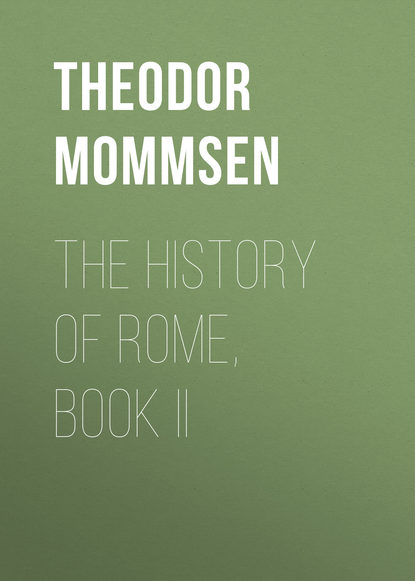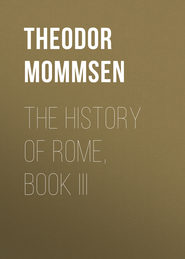По всем вопросам обращайтесь на: info@litportal.ru
(©) 2003-2024.
✖
The History of Rome, Book II
Настройки чтения
Размер шрифта
Высота строк
Поля
89
These were not the inhabitants of Satricum near Antium (II. V. League with The Hernici), but those of another Volscian town constituted at that time as a Roman burgess-community without right of voting, near Arpinum.
90
That a formal armistice for two years subsisted between the Romans and Samnites in 436-437 is more than improbable.
91
The operations in the campaign of 537, and still more plainly the formation of the highway from Arretium to Bononia in 567, show that the road from Rome to Arretium had already been rendered serviceable before that time. But it cannot at that period have been a Roman military road, because, judging from its later appellation of the "Cassian way," it cannot have been constructed as a -via consularis- earlier than 583; for no Cassian appears in the lists of Roman consuls and censors between Spurius Cassius, consul in 252, 261, and 268—who of course is out of the question—and Gaius Cassius Longinus, consul in 583.
92
The story that the Romans also sent envoys to Alexander at Babylon on the testimony of Clitarchus (Plin. Hist. Nat. iii. 5, 57), from whom the other authorities who mention this fact (Aristus and Asclepiades, ap. Arrian, vii. 15, 5; Memnon, c. 25) doubtless derived it. Clitarchus certainly was contemporary with these events; nevertheless, his Life of Alexander was decidedly a historical romance rather than a history; and, looking to the silence of the trustworthy biographers (Arrian, l. c.; Liv. ix. 18) and the utterly romantic details of the account—which represents the Romans, for instance, as delivering to Alexander a chaplet of gold, and the latter as prophesying the future greatness of Rome—we cannot but set down this story as one of the many embellishments which Clitarchus introduced into the history.
93
II. VI. Last Struggles of Samnium
94
Near the modern Anglona; not to be confounded with the better known town of the same name in the district of Cosenza.
95
These numbers appear credible. The Roman account assigns, probably in dead and wounded, 15,000 to each side; a later one even specifies 5000 as dead on the Roman, and 20,000 on the Greek side. These accounts may be mentioned here for the purpose of exhibiting, in one of the few instances where it is possible to check the statement, the untrustworthiness—almost without exception—of the reports of numbers, which are swelled by the unscrupulous invention of the annalists with avalanche-like rapidity.
96
The later Romans, and the moderns following them, give a version of the league, as if the Romans had designedly avoided accepting the Carthaginian help in Italy. This would have been irrational, and the facts pronounce against it. The circumstance that Mago did not land at Ostia is to be explained not by any such foresight, but simply by the fact that Latium was not at all threatened by Pyrrhus and so did not need Carthaginian aid; and the Carthaginians certainly fought for Rome in front of Rhegium.
97
II. IV. Victories of Salamis and Himera, and Their Effects
98
II. IV. Fruitlessness of the Celtic Victory
99
The grounds for assigning the document given in Polybius (iii. 22) not to 245, but to 406, are set forth in my Rom. Chronologie, p. 320 f. [translated in the Appendix to this volume].
100
II. V. Domination of the Romans; Exasperation of the Latins
101
II. VII. Breach between Rome and Tarentum
102
II. V. Colonization of the Volsci
103
II. V. Colonization of the Volsci
104
II. VI. New Fortresses in Apulia and Campania
105
II. VI. Last Struggles of Samnium
106
II. VII. Construction of New Fortresses and Roads
107
II. VII. The Boii
108
II. VII. Construction of New Fortresses and Roads
109
These were Pyrgi, Ostia, Antium, Tarracina, Minturnae, Sinuessa Sena Gallica, and Castrum Novum.
110
This statement is quite as distinct (Liv. viii. 14; -interdictum mari Antiati populo est-) as it is intrinsically credible; for Antium was inhabited not merely by colonists, but also by its former citizens who had been nursed in enmity to Rome (II. V. Colonizations in The Land Of The Volsci). This view is, no doubt, inconsistent with the Greek accounts, which assert that Alexander the Great (431) and Demetrius Poliorcetes (471) lodged complaints at Rome regarding Antiate pirates. The former statement is of the same stamp, and perhaps from the same source, with that regarding the Roman embassy to Babylon (II. VII. Relations Between The East and West). It seems more likely that Demetrius Poliorcetes may have tried by edict to put down piracy in the Tyrrhene sea which he had never set eyes upon, and it is not at all inconceivable that the Antiates may have even as Roman citizens, in defiance of the prohibition, continued for a time their old trade in an underhand fashion: much dependence must not however, be placed even on the second story.
111
II. VI. Last Campaigns in Samnium
112
II. VII. Decline of the Roman Naval Power
113
According to Servius (in Aen. iv. 628) it was stipulated in the Romano-Carthaginian treaties, that no Roman should set foot on (or rather occupy) Carthaginian, and no Carthaginian on Roman, soil, but Corsica was to remain in a neutral position between them (-ut neque Romani ad litora Carthaginiensium accederent neque Carthaginienses ad litora Romanorum…..Corsica esset media inter Romanos et Carthaginienses-). This appears to refer to our present period, and the colonization of Corsica seems to have been prevented by this very treaty.
These were not the inhabitants of Satricum near Antium (II. V. League with The Hernici), but those of another Volscian town constituted at that time as a Roman burgess-community without right of voting, near Arpinum.
90
That a formal armistice for two years subsisted between the Romans and Samnites in 436-437 is more than improbable.
91
The operations in the campaign of 537, and still more plainly the formation of the highway from Arretium to Bononia in 567, show that the road from Rome to Arretium had already been rendered serviceable before that time. But it cannot at that period have been a Roman military road, because, judging from its later appellation of the "Cassian way," it cannot have been constructed as a -via consularis- earlier than 583; for no Cassian appears in the lists of Roman consuls and censors between Spurius Cassius, consul in 252, 261, and 268—who of course is out of the question—and Gaius Cassius Longinus, consul in 583.
92
The story that the Romans also sent envoys to Alexander at Babylon on the testimony of Clitarchus (Plin. Hist. Nat. iii. 5, 57), from whom the other authorities who mention this fact (Aristus and Asclepiades, ap. Arrian, vii. 15, 5; Memnon, c. 25) doubtless derived it. Clitarchus certainly was contemporary with these events; nevertheless, his Life of Alexander was decidedly a historical romance rather than a history; and, looking to the silence of the trustworthy biographers (Arrian, l. c.; Liv. ix. 18) and the utterly romantic details of the account—which represents the Romans, for instance, as delivering to Alexander a chaplet of gold, and the latter as prophesying the future greatness of Rome—we cannot but set down this story as one of the many embellishments which Clitarchus introduced into the history.
93
II. VI. Last Struggles of Samnium
94
Near the modern Anglona; not to be confounded with the better known town of the same name in the district of Cosenza.
95
These numbers appear credible. The Roman account assigns, probably in dead and wounded, 15,000 to each side; a later one even specifies 5000 as dead on the Roman, and 20,000 on the Greek side. These accounts may be mentioned here for the purpose of exhibiting, in one of the few instances where it is possible to check the statement, the untrustworthiness—almost without exception—of the reports of numbers, which are swelled by the unscrupulous invention of the annalists with avalanche-like rapidity.
96
The later Romans, and the moderns following them, give a version of the league, as if the Romans had designedly avoided accepting the Carthaginian help in Italy. This would have been irrational, and the facts pronounce against it. The circumstance that Mago did not land at Ostia is to be explained not by any such foresight, but simply by the fact that Latium was not at all threatened by Pyrrhus and so did not need Carthaginian aid; and the Carthaginians certainly fought for Rome in front of Rhegium.
97
II. IV. Victories of Salamis and Himera, and Their Effects
98
II. IV. Fruitlessness of the Celtic Victory
99
The grounds for assigning the document given in Polybius (iii. 22) not to 245, but to 406, are set forth in my Rom. Chronologie, p. 320 f. [translated in the Appendix to this volume].
100
II. V. Domination of the Romans; Exasperation of the Latins
101
II. VII. Breach between Rome and Tarentum
102
II. V. Colonization of the Volsci
103
II. V. Colonization of the Volsci
104
II. VI. New Fortresses in Apulia and Campania
105
II. VI. Last Struggles of Samnium
106
II. VII. Construction of New Fortresses and Roads
107
II. VII. The Boii
108
II. VII. Construction of New Fortresses and Roads
109
These were Pyrgi, Ostia, Antium, Tarracina, Minturnae, Sinuessa Sena Gallica, and Castrum Novum.
110
This statement is quite as distinct (Liv. viii. 14; -interdictum mari Antiati populo est-) as it is intrinsically credible; for Antium was inhabited not merely by colonists, but also by its former citizens who had been nursed in enmity to Rome (II. V. Colonizations in The Land Of The Volsci). This view is, no doubt, inconsistent with the Greek accounts, which assert that Alexander the Great (431) and Demetrius Poliorcetes (471) lodged complaints at Rome regarding Antiate pirates. The former statement is of the same stamp, and perhaps from the same source, with that regarding the Roman embassy to Babylon (II. VII. Relations Between The East and West). It seems more likely that Demetrius Poliorcetes may have tried by edict to put down piracy in the Tyrrhene sea which he had never set eyes upon, and it is not at all inconceivable that the Antiates may have even as Roman citizens, in defiance of the prohibition, continued for a time their old trade in an underhand fashion: much dependence must not however, be placed even on the second story.
111
II. VI. Last Campaigns in Samnium
112
II. VII. Decline of the Roman Naval Power
113
According to Servius (in Aen. iv. 628) it was stipulated in the Romano-Carthaginian treaties, that no Roman should set foot on (or rather occupy) Carthaginian, and no Carthaginian on Roman, soil, but Corsica was to remain in a neutral position between them (-ut neque Romani ad litora Carthaginiensium accederent neque Carthaginienses ad litora Romanorum…..Corsica esset media inter Romanos et Carthaginienses-). This appears to refer to our present period, and the colonization of Corsica seems to have been prevented by this very treaty.








